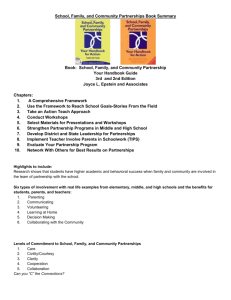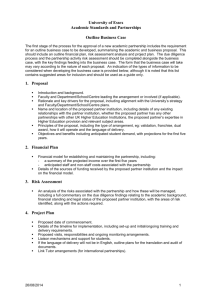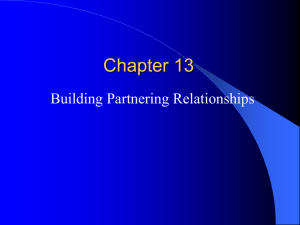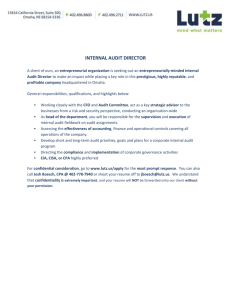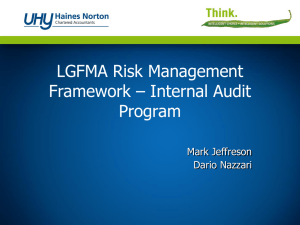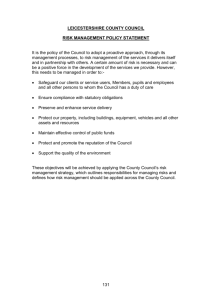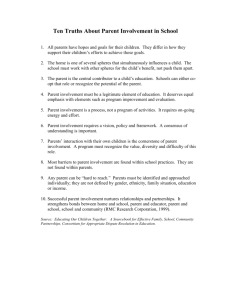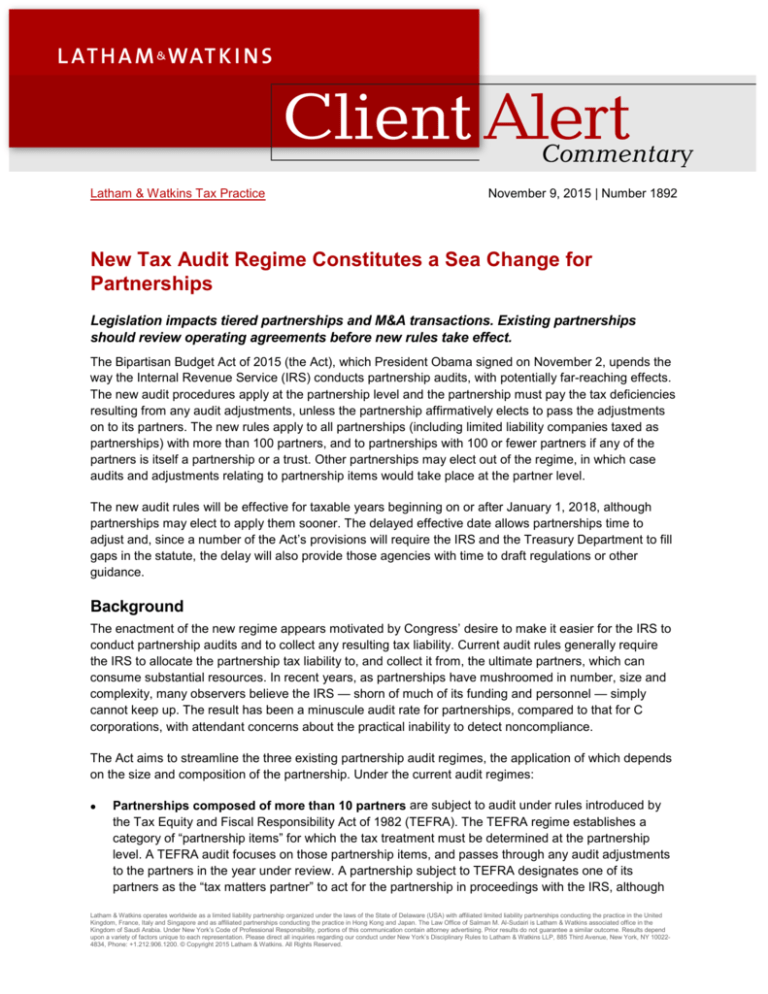
Latham & Watkins Tax Practice
November 9, 2015 | Number 1892
New Tax Audit Regime Constitutes a Sea Change for
Partnerships
Legislation impacts tiered partnerships and M&A transactions. Existing partnerships
should review operating agreements before new rules take effect.
The Bipartisan Budget Act of 2015 (the Act), which President Obama signed on November 2, upends the
way the Internal Revenue Service (IRS) conducts partnership audits, with potentially far-reaching effects.
The new audit procedures apply at the partnership level and the partnership must pay the tax deficiencies
resulting from any audit adjustments, unless the partnership affirmatively elects to pass the adjustments
on to its partners. The new rules apply to all partnerships (including limited liability companies taxed as
partnerships) with more than 100 partners, and to partnerships with 100 or fewer partners if any of the
partners is itself a partnership or a trust. Other partnerships may elect out of the regime, in which case
audits and adjustments relating to partnership items would take place at the partner level.
The new audit rules will be effective for taxable years beginning on or after January 1, 2018, although
partnerships may elect to apply them sooner. The delayed effective date allows partnerships time to
adjust and, since a number of the Act’s provisions will require the IRS and the Treasury Department to fill
gaps in the statute, the delay will also provide those agencies with time to draft regulations or other
guidance.
Background
The enactment of the new regime appears motivated by Congress’ desire to make it easier for the IRS to
conduct partnership audits and to collect any resulting tax liability. Current audit rules generally require
the IRS to allocate the partnership tax liability to, and collect it from, the ultimate partners, which can
consume substantial resources. In recent years, as partnerships have mushroomed in number, size and
complexity, many observers believe the IRS — shorn of much of its funding and personnel — simply
cannot keep up. The result has been a minuscule audit rate for partnerships, compared to that for C
corporations, with attendant concerns about the practical inability to detect noncompliance.
The Act aims to streamline the three existing partnership audit regimes, the application of which depends
on the size and composition of the partnership. Under the current audit regimes:
•
Partnerships composed of more than 10 partners are subject to audit under rules introduced by
the Tax Equity and Fiscal Responsibility Act of 1982 (TEFRA). The TEFRA regime establishes a
category of “partnership items” for which the tax treatment must be determined at the partnership
level. A TEFRA audit focuses on those partnership items, and passes through any audit adjustments
to the partners in the year under review. A partnership subject to TEFRA designates one of its
partners as the “tax matters partner” to act for the partnership in proceedings with the IRS, although
Latham & Watkins operates worldwide as a limited liability partnership organized under the laws of the State of Delaware (USA) with affiliated limited liability partnerships conducting the practice in the United
Kingdom, France, Italy and Singapore and as affiliated partnerships conducting the practice in Hong Kong and Japan. The Law Office of Salman M. Al-Sudairi is Latham & Watkins associated office in the
Kingdom of Saudi Arabia. Under New York’s Code of Professional Responsibility, portions of this communication contain attorney advertising. Prior results do not guarantee a similar outcome. Results depend
upon a variety of factors unique to each representation. Please direct all inquiries regarding our conduct under New York’s Disciplinary Rules to Latham & Watkins LLP, 885 Third Avenue, New York, NY 100224834, Phone: +1.212.906.1200. © Copyright 2015 Latham & Watkins. All Rights Reserved.
all partners have certain information and notice rights and may participate in the proceedings. The
TEFRA regime also applies to partnerships with 10 or fewer partners if any partner is a partnership or
trust.
•
Small partnerships composed of 10 or fewer partners, each of whom is an individual (other than a
nonresident alien), a C corporation or an estate of a deceased partner, are subject to audit under the
same procedures that apply to individual taxpayers, unless the small partnership elects to be subject
to TEFRA.
•
Electing large partnerships composed of at least 100 partners generally are subject to a
simplified version of the TEFRA audit regime which, among other things, generally affords partners
considerably lesser participation rights than under a regular TEFRA audit.
Congress reportedly incorporated the new partnership audit provisions into the budget bill as potential
revenue-raisers. If the IRS can conduct these audits more easily, the reasoning goes, it will conduct more
of them and collect more taxes. In fact, after the Act’s passage, press reports cited an IRS official as
stating the agency plans to train examiners to identify and handle partnership issues. Other recent tax
reform proposals generally endorsed the audit reform approach reflected in the Act, as did President
Obama’s fiscal year 2016 budget proposal, which counted streamlining audit and adjustment procedure
for large partnerships as a deficit-reduction measure. 1
Key Aspects of New Regime
The Act creates a new default audit regime that applies to all partnerships unless a partnership is eligible
to elect out of the regime and makes the election. Under the new default audit regime, the IRS generally
will conduct audits and make any resulting adjustments at the partnership level, and if the IRS finds a
deficiency, it will impose tax on the partnership itself (rather than on the partners) at the highest individual
or corporate tax rate in effect for the year under examination. The Act authorizes the IRS to prescribe
rules that will allow a partnership to reduce the liability by demonstrating, for example, that some of its
partners are subject to a lower rate or are tax-exempt. Audit adjustments that do not result in a deficiency
generally are required to be taken into account by the partnership as an adjustment to its bottom-line
taxable income or loss in the year of the adjustment, rather than amending returns for prior years.
As an alternative to partnership-level liability, the partnership may elect to furnish adjusted Schedules K-1
to each person who was a partner in the reviewed year and to the IRS, stating such partner’s share of
any partnership adjustments. Those partners would then take the adjustments into account on their own
returns in the year in which they receive their adjusted Schedules K-1 (rather than by amending their
returns for the reviewed year), using what has been described as a simplified amended-return process.
The Act leaves it to the IRS to draft the precise contours of this election, including the time and manner of
furnishing the adjusted Schedules K-1, although the Act specifies that the partnership must elect this
alternative method within 45 days after the notice of final partnership adjustment.
In addition, the Act provides procedures for a partnership to self-report adjustments for prior taxable
years. A partnership may file with the IRS a request for an administrative adjustment with respect to a
prior year and take the adjustment into account in the year in which the partnership made the
administrative adjustment request. The partnership generally could then either take the adjustment into
account at the partnership level in the adjustment year and pay any resulting tax or furnish adjusted
Schedules K-1 to the reviewed-year partners, who would then take the adjustment into account in the
year in which they receive the adjusted Schedules K-1.
Latham & Watkins
November 9, 2015 | Number 1892 | Page 2
The Act replaces the “tax matters partner” with a partnership representative, who need not be a partner
but must have a substantial presence in the United States, to assume sole authority to act for the
partnership in an audit. If the partnership fails to designate a representative, the IRS may select any
person to fill the role. This change resolves many unanswered questions as to who could serve as the tax
matters partner for a limited liability company under existing TEFRA rules. Actions the partnership takes
under the new regime, and any final decision in a proceeding under the new regime with respect to the
partnership, will be binding on the partnership and its partners.
Partnerships composed of 100 or fewer partners and whose partners do not include any partnerships or
trusts may elect out of the new regime. The partnership must timely make the election annually on its
partnership return, and must notify all partners of the election. The rules require the partnership to report
to the IRS the name and taxpayer identification number of each partner, including each shareholder of
any S corporation that is a partner. Each such S corporation shareholder counts toward the 100-partner
limit for the partnership to be eligible to elect out of the new audit regime. Although generally a smaller
partnership may elect out of the new rules only if no partner is a partnership or a trust, the Act authorizes
the IRS to issue guidance relaxing this restriction, provided the partnership can report information about
the partners’ owners in a manner similar to the disclosure regarding S corporation shareholders.
Impact on M&A and Tiered Partnerships
The imposition of entity-level liability for income taxes has significant implications in the context of
mergers and acquisitions involving partnerships and will heighten concerns over whether an acquirer or
successor to a former partnership is considered a continuation of that partnership for tax purposes. The
Act contemplates that if a partnership has ceased to exist at the time of the audit, the adjustments will be
taken into account by, and any resulting tax liability will be the obligation of, the partners of the
partnership for the audited year. However, the implementation of this rule has been left to the IRS.
Accordingly, if an acquirer is considered a continuation of the acquired partnership, then it appears the
acquirer would succeed to any potential pre-closing tax liabilities of the acquired partnership. However, if
an acquirer is not considered a continuation of the acquired partnership, then it appears that those
liabilities would be left behind. Transaction parties will need to take account of the new audit rules when
negotiating who will bear the economic cost of taxes imposed at the partnership level, who will control
audits for pre-closing periods and what elections the partnership will be allowed to make.
In the context of tiered partnerships, whether upper-tier partnerships may fully avail themselves of the
alternative procedure allowing a partnership to shift the tax liability from the partnership to the reviewedyear partners by issuing adjusted Schedules K-1 is unclear. The Act provides that taxes of the reviewedyear partners will be increased accordingly, in the year in which they receive their adjusted Schedules
K-1. If the partnership under audit (the lower-tier partnership, or LTP) has a reviewed-year partner that is
itself a partnership (the upper-tier partnership, or UTP), the statutory language suggests that UTP must
take the adjustment into account in the year in which it received the adjusted Schedule K-1 from LTP. In
such event, UTP’s partners in that year would bear the burden of the adjustment, even though they may
be different from UTP’s partners in the LTP year under audit. Congress may have meant to permit “tiering
up” the adjustment, such that UTP could issue adjusted Schedules K-1 to the persons who were its
partners in the LTP year under audit, and so on up the chain. Congress may need to clarify its intention,
or perhaps the IRS has sufficient authority under the Act to issue clarifying guidance on this question.
Conclusion
The replacement of the TEFRA and electing large partnership rules with the new partnership audit regime
presents numerous challenges for partnerships. Small partnerships will have to decide whether they want
to elect out of the new regime, thereby weakening the ability to control consistent partner reporting.
Latham & Watkins
November 9, 2015 | Number 1892 | Page 3
Partnerships that do not elect out or that are ineligible to elect out will need to ensure their operating
agreements address the new procedural requirements, such as addressing whether the partnership is
required to elect to pass-through audit adjustments to the partners or who will have the authority to make
that decision. Partnerships that want to shift the economic liability of partnership audit adjustments to
persons who were partners during the reviewed year will need to comply with an election procedure, as
yet largely unwritten, within a limited time frame. In the M&A context, the new regime’s default rule to
impose liability on the partnership during the adjustment year rather than the reviewed year highlights the
importance of indemnification provisions in partnership acquisition and investment agreements. Congress
has left many details of the new regime to the IRS and may need to enact technical corrections to clarify
certain aspects of the law. Partnerships, partners and their advisors will need to study carefully any future
guidance from Congress or the IRS to implement the new rules.
If you have questions about this Client Alert, please contact one of the authors listed below or the Latham
lawyer with whom you normally consult:
David S. Raab
david.raab@lw.com
+1.212.906.1344
New York
Julie M. Marion
julie.marion@lw.com
+1.312.876.7700
Chicago
Thomas H. Halpern
Knowledge Management Lawyer
thomas.halpern@lw.com
+1.213.891.8684
Los Angeles
You Might Also Be Interested In
OECD Publishes Final BEPS Project Reports
IRS Adds Certain Spin Transactions to the “No Rule” List
IRS Issues Proposed Regulations Addressing Management Fee Waivers
Client Alert is published by Latham & Watkins as a news reporting service to clients and other friends.
The information contained in this publication should not be construed as legal advice. Should further
analysis or explanation of the subject matter be required, please contact the lawyer with whom you
normally consult. The invitation to contact is not a solicitation for legal work under the laws of any
jurisdiction in which Latham lawyers are not authorized to practice. A complete list of Latham’s Client
Alerts can be found at www.lw.com. If you wish to update your contact details or customize the
information you receive from Latham & Watkins, visit http://events.lw.com/reaction/subscriptionpage.html
to subscribe to the firm’s global client mailings program.
Endnote
1
Of some comfort to partnerships, unlike some previous similar proposals, the Act does not impose joint and several liability on
partners for liabilities determined at the partnership level.
Latham & Watkins
November 9, 2015 | Number 1892 | Page 4



